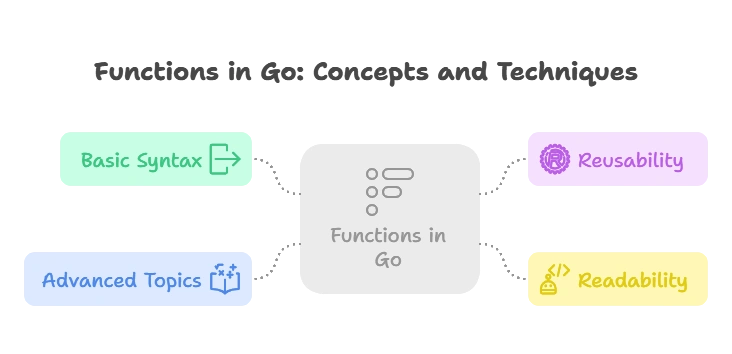Functions in Go
Functions are essential building blocks of any programming language, including Go. They allow developers to break down complex tasks into smaller, manageable pieces of code, making programs more modular, reusable, and easier to understand. This chapter aims to provide a comprehensive guide to functions in Go, covering everything from basic function syntax to advanced concepts like closures and anonymous functions.
Basic Function Syntax
In Go, a function is defined using the func keyword followed by the function name, parameters (if any), return type (if any), and the function body enclosed in curly braces {}. Let’s explore a basic example:
package main
import "fmt"
// Function to add two numbers
func add(x, y int) int {
return x + y
}
func main() {
result := add(10, 20)
fmt.Println("Sum:", result)
}
- We define a function named
addthat takes two parametersxandyof typeintand returns their sum. - Inside the
mainfunction, we call theaddfunction with arguments 10 and 20 and assign the result to theresultvariable. - We then print the result to the console.
Multiple Return Values
In Go, a function can return multiple values. This is particularly useful when a function needs to return more than one result. Let’s see an example:
package main
import "fmt"
// Function to divide two numbers
func divide(x, y int) (int, int) {
quotient := x / y
remainder := x % y
return quotient, remainder
}
func main() {
q, r := divide(10, 3)
fmt.Println("Quotient:", q)
fmt.Println("Remainder:", r)
}
- We define a function named
dividethat takes two parametersxandyof typeintand returns their quotient and remainder. - Inside the function, we calculate the quotient and remainder using the division and modulus operators.
- In the
mainfunction, we call thedividefunction with arguments 10 and 3 and assign the returned values to variablesqandr. - We then print the quotient and remainder to the console.
Named Return Values
Go allows specifying names for return values in a function signature. This can make the code more readable and self-documenting. Let’s see an example:
package main
import "fmt"
// Function to calculate the area and perimeter of a rectangle
func rectangleProperties(length, width float64) (area, perimeter float64) {
area = length * width
perimeter = 2 * (length + width)
return // Implicit return of named variables 'area' and 'perimeter'
}
func main() {
a, p := rectangleProperties(5.0, 3.0)
fmt.Println("Area:", a)
fmt.Println("Perimeter:", p)
}
- We define a function named
rectanglePropertiesthat takes two parameterslengthandwidthof typefloat64and returns their area and perimeter. - Inside the function, we calculate the area and perimeter of the rectangle.
- We use named return values
areaandperimeterin the function signature. - In the
mainfunction, we call therectanglePropertiesfunction with arguments 5.0 and 3.0 and assign the returned values to variablesaandp. - We then print the area and perimeter to the console.
Variadic Functions
A variadic function in Go is a function that can accept a variable number of arguments. This is achieved by specifying an ellipsis (...) before the type of the last parameter. Let’s see an example
package main
import "fmt"
// Variadic function to calculate the sum of numbers
func sum(nums ...int) int {
total := 0
for _, num := range nums {
total += num
}
return total
}
func main() {
fmt.Println("Sum:", sum(1, 2, 3, 4, 5))
}
- We define a variadic function named
sumthat accepts a variable number of integers as arguments. - Inside the function, we iterate over the
numsslice and calculate the total sum of all numbers. - In the
mainfunction, we call thesumfunction with multiple arguments and print the result to the console.
Anonymous Functions
Anonymous functions, also known as function literals, are functions without a name. They are commonly used in Go for defining inline functions or closures. Let’s see an example:
package main
import "fmt"
func main() {
// Anonymous function to calculate the square of a number
square := func(x int) int {
return x * x
}
fmt.Println("Square of 5:", square(5))
}
- We define an anonymous function and assign it to the variable
square. - The anonymous function takes an integer parameter
xand returns its square. - In the
mainfunction, we call the anonymous function with argument 5 and print the result to the console.
Function Closures
A closure in Go is a function value that references variables from outside its body. These variables are then bound to the closure, allowing the closure to access and modify them even after the outer function has finished execution. Let’s see an example:
package main
import "fmt"
func main() {
// Function closure to generate Fibonacci numbers
fib := fibonacci()
for i := 0; i < 10; i++ {
fmt.Println(fib())
}
}
func fibonacci() func() int {
a, b := 0, 1
return func() int {
result := a
a, b = b, a+b
return result
}
}
- We define a function named
fibonaccithat returns a function closure. - Inside the
fibonaccifunction, we declare two variablesaandbto keep track of the current and next Fibonacci numbers. - We return an anonymous function that calculates and returns the next Fibonacci number in the sequence.
- In the
mainfunction, we create a closurefibby calling thefibonaccifunction. - We then use the closure to generate and print the first 10 Fibonacci numbers.

Functions are the building blocks of any Go program, allowing developers to encapsulate logic, promote reusability, and improve code readability. By mastering the concepts and techniques presented in this chapter, you'll be well-equipped to write modular, efficient, and maintainable code in Go. From basic function syntax to advanced topics like closures and anonymous functions, this chapter covers everything you need to become proficient in writing functions in Go. Happy coding !❤️
